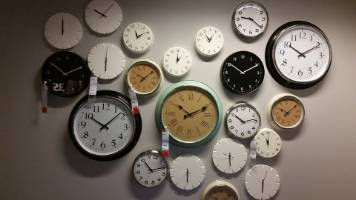Summary
Students will begin by discussing what clocks do and using prior knowledge to compare analog, digital, and written time in a matching game. They will then work as a class to learn how to tell time using the different clocks and create a visual guide of their routines. Differentiation and parent extension ideas are also included in this lesson.
Essential Question(s)
Why do we communicate time?
Snapshot
Engage
Students draw a picture of what they think a clock looks like and discuss what the clock does.
Explore
Students match the written, digital, and analog clock times and discuss the different ways we tell time.
Explain
Students learn about digital and analog clocks and how to tell time. They then rework their card sorts from the Explore phase.
Extend
Students create a schedule of their day.
Evaluate
Students share their schedules with the people at their table.
Materials
Telling Time Matching Cards, cut and separated into baggies or envelopes for pairs of students
Telling Time Schedule Template handout
Telling Time - Practice sheet (optional)
Clock manipulatives (optional)
Engage
Ask students to draw picture of a clock on a sheet of paper. Students may draw an analog or a digital clock, whatever they prefer. Tell students to add as many details to their drawing as they can.
Using the Tell Me Everything strategy, have students write down different ways they use a clock around the picture of their clock. As a class, discuss the ways we use a clock.
Explore
Use an Elbow Partners strategy to pair students up for the next activity. Use a Card Sort strategy and have students sort the Telling Time Matching Cards in sets of three by putting together the digital, analog, and written times that are the same.
Discuss that people read and write time in a variety of ways and tell students that today we will focus on using digital and analog clocks.
Explain
Draw a digital clock on the board and, as a class, talk about the different parts that help us read the time, For example, show students where to find the hour, minutes and AM/PM indicator, as well as the use of a colon to separate hours and minutes.
Explain how to tell time on a digital clock, focusing on the quarter hours. Have students practice writing and reading by drawing a few examples.
Using manipulatives, if available, build an analog clock as a class and talk about the different parts that help us read the time. For example, point out the minute hand, the second hand, the numerals around the perimeter, and the significance of each. If you don't have clock manipulatives, you can draw a picture on the board and have a class discussion about the parts of the clock.
Review how to tell time on an analog clock, focusing on the quarter hours. Have students practice writing and reading with a few examples.
Give students a chance to reorganize their Card Sorts based on their new understanding.
Extend
Ask students to create a daily schedule that outlines what times they do different things. Pass out copies of the attached Telling Time Schedule Template or ask students to get out a sheet of paper to create their schedule.
Evaluate
Choosing a new Elbow Partner, have students share their schedule with someone else at the table. Circulate to observe the conversations and take note of students' mastery of the concept.
Resources
Harris, T., & Hartman, C. (2010). "The clock struck one: A time-telling tale." Toronto: Scholastic.
K20 Center. (n.d.). Card sort. Strategies. Retrieved from https://learn.k20center.ou.edu/strategy/d9908066f654727934df7bf4f506976b
K20 Center. (n.d.). Elbow partners. Strategies. Retrieved from https://learn.k20center.ou.edu/strategy/ccc07ea2d6099763c2dbc9d05b00c4b4
K20 Center. (n.d.). Tell me everything. Strategies. Retrieved from https://learn.k20center.ou.edu/strategy/baee4e90c5fa1a7060ca04dd8b001ea4
Sierra, J., & Cushman, D. (2007). "What time is it, Mr. Crocodile?". Orlando, FL: Voyager Books.


